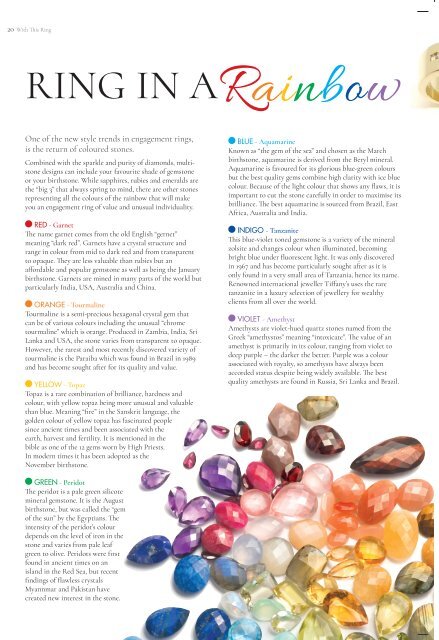With This Ring: March 23, 2018
You also want an ePaper? Increase the reach of your titles
YUMPU automatically turns print PDFs into web optimized ePapers that Google loves.
20 <strong>With</strong> <strong>This</strong> <strong>Ring</strong><br />
RING IN A<br />
Rainbow<br />
One of the new style trends in engagement rings,<br />
is the return of coloured stones.<br />
Combined with the sparkle and purity of diamonds, multistone<br />
designs can include your favourite shade of gemstone<br />
or your birthstone. While sapphires, rubies and emeralds are<br />
the “big 3” that always spring to mind, there are other stones<br />
representing all the colours of the rainbow that will make<br />
you an engagement ring of value and unusual individuality.<br />
RED - Garnet<br />
The name garnet comes from the old English “gernet”<br />
meaning “dark red”. Garnets have a crystal structure and<br />
range in colour from mid to dark red and from transparent<br />
to opaque. They are less valuable than rubies but an<br />
affordable and popular gemstone as well as being the January<br />
birthstone. Garnets are mined in many parts of the world but<br />
particularly India, USA, Australia and China.<br />
ORANGE - Tourmaline<br />
Tourmaline is a semi-precious hexagonal crystal gem that<br />
can be of various colours including the unusual “chrome<br />
tourmaline” which is orange. Produced in Zambia, India, Sri<br />
Lanka and USA, the stone varies from transparent to opaque.<br />
However, the rarest and most recently discovered variety of<br />
tourmaline is the Paraiba which was found in Brazil in 1989<br />
and has become sought after for its quality and value.<br />
YELLOW - Topaz<br />
Topaz is a rare combination of brilliance, hardness and<br />
colour, with yellow topaz being more unusual and valuable<br />
than blue. Meaning “fire” in the Sanskrit language, the<br />
golden colour of yellow topaz has fascinated people<br />
since ancient times and been associated with the<br />
earth, harvest and fertility. It is mentioned in the<br />
bible as one of the 12 gems worn by High Priests.<br />
In modern times it has been adopted as the<br />
November birthstone.<br />
BLUE - Aquamarine<br />
Known as “the gem of the sea” and chosen as the <strong>March</strong><br />
birthstone, aquamarine is derived from the Beryl mineral.<br />
Aquamarine is favoured for its glorious blue-green colours<br />
but the best quality gems combine high clarity with ice blue<br />
colour. Because of the light colour that shows any flaws, it is<br />
important to cut the stone carefully in order to maximise its<br />
brilliance. The best aquamarine is sourced from Brazil, East<br />
Africa, Australia and India.<br />
INDIGO - Tanzanite<br />
<strong>This</strong> blue-violet toned gemstone is a variety of the mineral<br />
zolsite and changes colour when illuminated, becoming<br />
bright blue under fluorescent light. It was only discovered<br />
in 1967 and has become particularly sought after as it is<br />
only found in a very small area of Tanzania, hence its name.<br />
Renowned international jeweller Tiffany’s uses the rare<br />
tanzanite in a luxury selection of jewellery for wealthy<br />
clients from all over the world.<br />
VIOLET - Amethyst<br />
Amethysts are violet-hued quartz stones named from the<br />
Greek “amethystos” meaning “intoxicate”. The value of an<br />
amethyst is primarily in its colour, ranging from violet to<br />
deep purple – the darker the better. Purple was a colour<br />
associated with royalty, so amethysts have always been<br />
accorded status despite being widely available. The best<br />
quality amethysts are found in Russia, Sri Lanka and Brazil.<br />
GREEN - Peridot<br />
The peridot is a pale green silicote<br />
mineral gemstone. It is the August<br />
birthstone, but was called the “gem<br />
of the sun” by the Egyptians. The<br />
intensity of the peridot’s colour<br />
depends on the level of iron in the<br />
stone and varies from pale leaf<br />
green to olive. Peridots were first<br />
found in ancient times on an<br />
island in the Red Sea, but recent<br />
findings of flawless crystals<br />
Myannmar and Pakistan have<br />
created new interest in the stone.


















